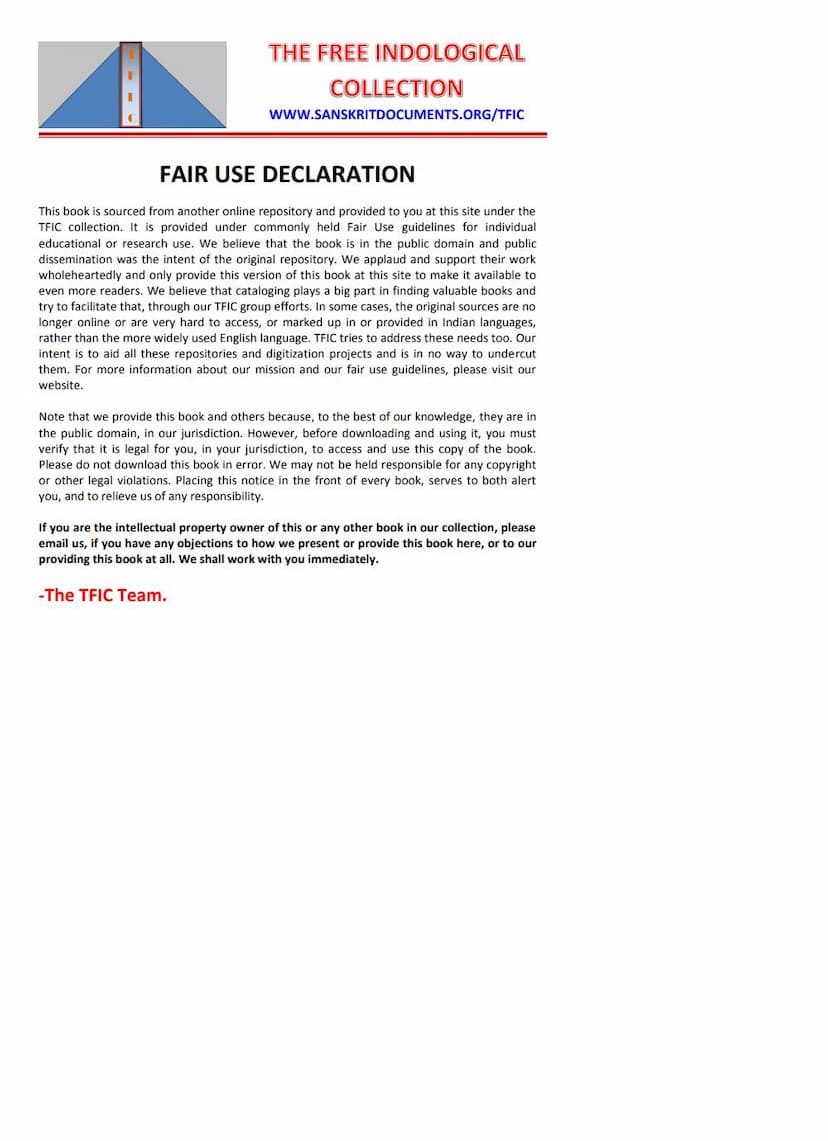Jain Stotra Puja Path Sangraha
Added to library: September 2, 2025

Summary
This comprehensive summary is based on the Jain text "Jain Stotra Puja Path Sangraha" by Veer Pustak Bhandar Jaipur.
Overall Scope and Purpose:
The "Jain Stotra Puja Path Sangraha" is a collection of Jain devotional hymns (stotras), prayers, and ritualistic texts (puja path) intended for daily use and for special festivals. It serves as a comprehensive guide for Jain devotees to perform worship and engage in spiritual practices, encompassing a wide range of deities, principles, and significant events in Jainism. The text aims to provide accessible devotional material, often in vernacular languages, to facilitate spiritual connection and merit accumulation.
Key Sections and Content:
The book is structured into numerous chapters and sections, each dedicated to specific aspects of Jain worship and philosophy. Based on the table of contents (pages 7-8) and the subsequent text, the major categories include:
- Mangalacharan (Invocation): Starts with auspicious beginnings, invoking the divine and seeking blessings for the recitation and worship.
- Nitya Puja (Daily Worship): Includes texts for daily rituals, such as Abhishek Path (ritualistic bathing of idols), Vinay Path (path of humility and respect), and the commencement of puja.
- Dev-Shastra-Guru Puja (Worship of the Three Jewels): Dedicated to the worship of the Arihants (victorious ones), the Jain scriptures (Shastra), and the enlightened monks (Guru). This section features various hymns and puja rituals for these fundamental entities.
- Tirthankar Pujas: A significant portion of the book is dedicated to the worship of the Tirthankaras, the spiritual guides of Jainism. This includes:
- Visha Tirthankar Bhasha Puja (Worship of the Twenty Tirthankaras in Vernacular Language): A section specifically for the twenty Tirthankaras, often presented in a more accessible language.
- Choubis Tirthankar Pujas (Worship of the Twenty-four Tirthankaras): Includes pujas for the entire lineage of Tirthankaras, often with explanations or meanings.
- Pujas for Specific Tirthankaras: Features dedicated pujas for prominent Tirthankaras like Adinath (Rishabhdev), Chandraprabh, Neminath, Parshvanath, and Mahavir.
- Siddha Puja (Worship of the Siddhas): Text for worshipping the liberated souls (Siddhas) who have attained omniscience and eternal bliss. This includes various forms of Siddha puja like Dravyashtak (eightfold material worship) and Bhavashtak (eightfold internal worship), as well as Siddha Chakra Puja.
- Pujas for Sacred Sites (Tirtha Kshetra Puja): Devotional texts for specific holy places where Tirthankaras attained liberation or performed significant spiritual acts, such as Samphel Shikhar, Pavapur, Girnar, and Chhapaipur.
- Special Pujas for Festivals and Observances: Includes pujas relevant to particular Jain festivals and vows, such as:
- Panchmeru Puja (Worship of the five sacred mountains in Jain cosmology).
- Nandishwar Dwip (Ashtahnika) Puja (Worship associated with the sacred island of Nandishwar).
- Dash Lakshana Dharma Puja (Worship dedicated to the ten virtues).
- Ratnatraya Puja (Worship of the three jewels: Right Faith, Right Knowledge, Right Conduct).
- Ravi Vrat Puja (Worship related to a specific vow, likely observed on a Sunday).
- Raksha Bandhan Puja and Saluna Parva Puja (Worship related to specific festivals).
- Panch Kalyanak Pujas (Worship commemorating the five auspicious events in a Tirthankara's life: Conception, Birth, Renunciation, Omniscience, and Liberation).
- Devi Pujas: Includes worship of Saraswati (Goddess of knowledge) and other specific goddesses.
- Guru Puja: Devotional texts dedicated to revering the spiritual lineage and preceptors.
- Stotras and Bhajans: A collection of hymns and devotional songs praising the divine.
- Chalisas: Devotional verses, typically forty verses long, dedicated to specific deities like Mahavir and Parshvanath.
- Other Important Texts: Includes Navagraha Arishta Nivarak Puja (remedial worship for planetary afflictions), Kalikund Parshvanath Puja, Visha Tirthankar Puja, Panch Parameshthi Jayamala (garland of victory for the five supreme beings), Shanti Paath (peace chants in Sanskrit and vernacular), and Vraton Ki Jayan (victory chants for vows).
- Shastra Swadhyay (Study of Scriptures): This section contains introductory prayers and verses for scriptural study, including the Namokar Mantra and other important invocations. It highlights the importance of scriptural learning in Jainism.
Key Themes and Principles:
- Devotion and Reverence: The core of the book is fostering deep devotion towards the Arihants, Siddhas, Acharyas, Upadhyayas, and Sadhus (the five supreme beings or Panch Parmeshthi), the scriptures, and the Tirthankaras.
- Merit Accumulation (Punya): The act of performing these pujas and reciting these stotras is understood to generate merit, leading to positive karma and spiritual progress.
- Spiritual Purity and Discipline: Rituals like Abhishek and the offering of eightfold items (Ashtadravya) symbolize the purification of the soul and the shedding of karmas.
- Understanding Jain Philosophy: Through explanations of Tirthankaras, their symbols, the Tirthas, and the concept of the Panch Kalyanak, the book subtly imparts key Jain teachings.
- Accessibility: The inclusion of vernacular language versions (Bhasha) indicates an effort to make these practices accessible to a wider audience.
- Holistic Approach: The collection covers various levels of devotion, from daily rituals to specific festival observances, and from elaborate pujas to simpler hymns and chants.
Fair Use Declaration:
The provided text includes a "Fair Use Declaration" from "The Free Indological Collection" (TFIC). This declaration states that the book is sourced from another online repository and provided under Fair Use guidelines for educational or research purposes. TFIC believes the book to be in the public domain and supports digitization efforts to make rare or hard-to-access texts available in English. They emphasize that their intent is to aid and not undercut other repositories and ask users to verify the legality of use in their jurisdiction.
Overall Impression:
"Jain Stotra Puja Path Sangraha" is a valuable resource for understanding and practicing Jain devotional rituals. Its extensive coverage, from foundational principles to specific practices associated with various Tirthankaras and holy sites, makes it a comprehensive manual for Jain spiritual life. The book reflects the rich devotional heritage of Jainism and its emphasis on sincere worship and adherence to spiritual principles.